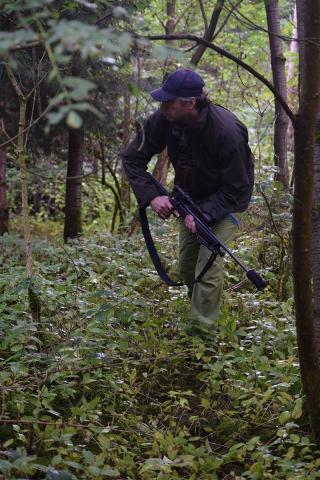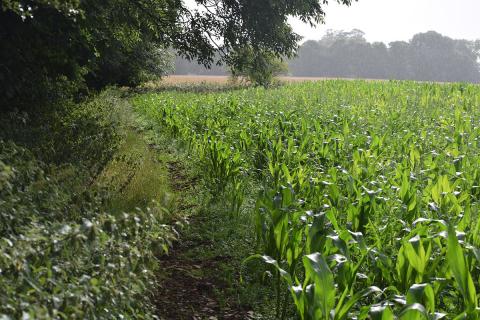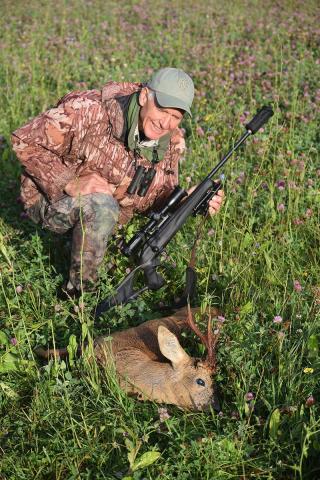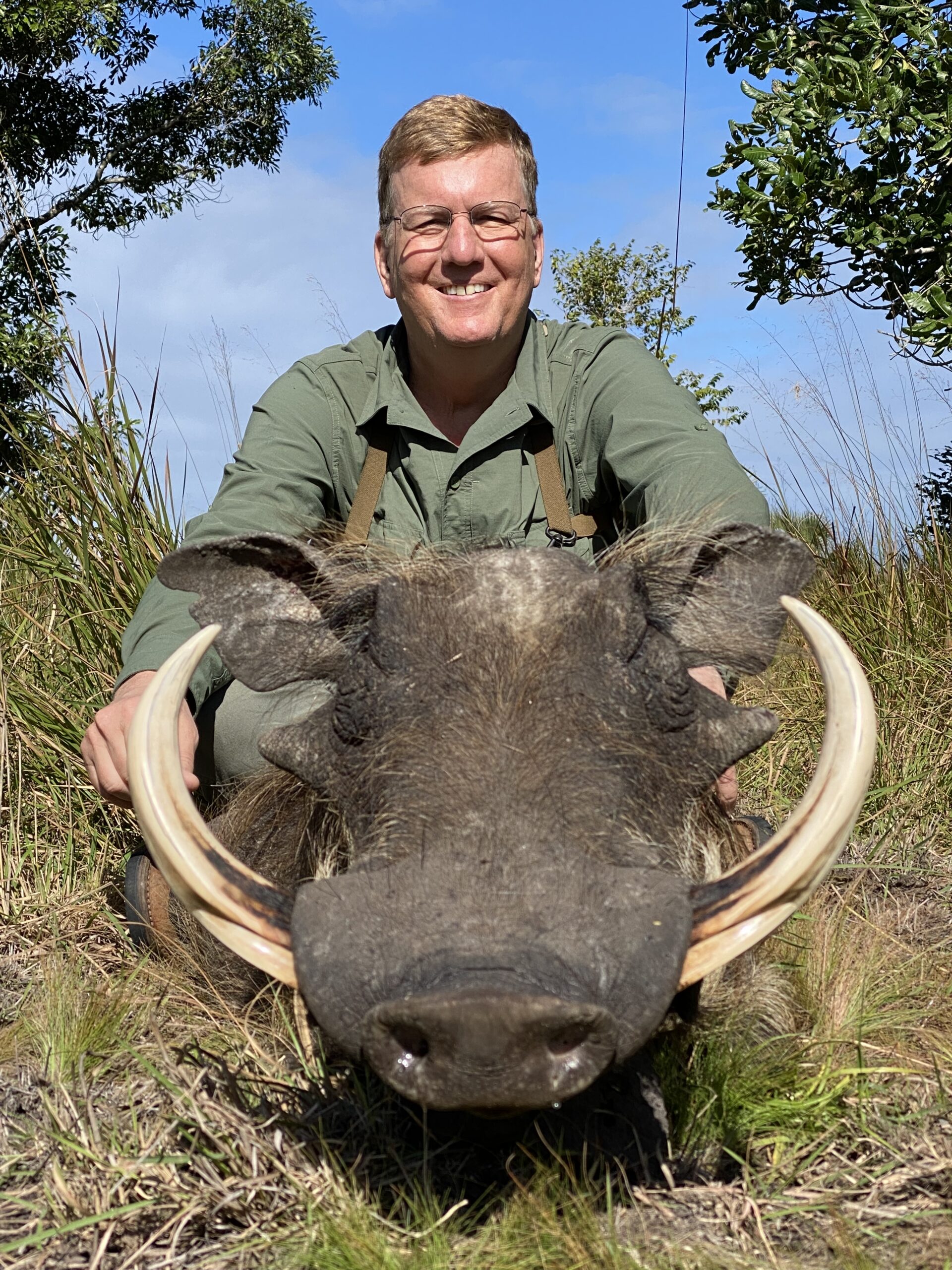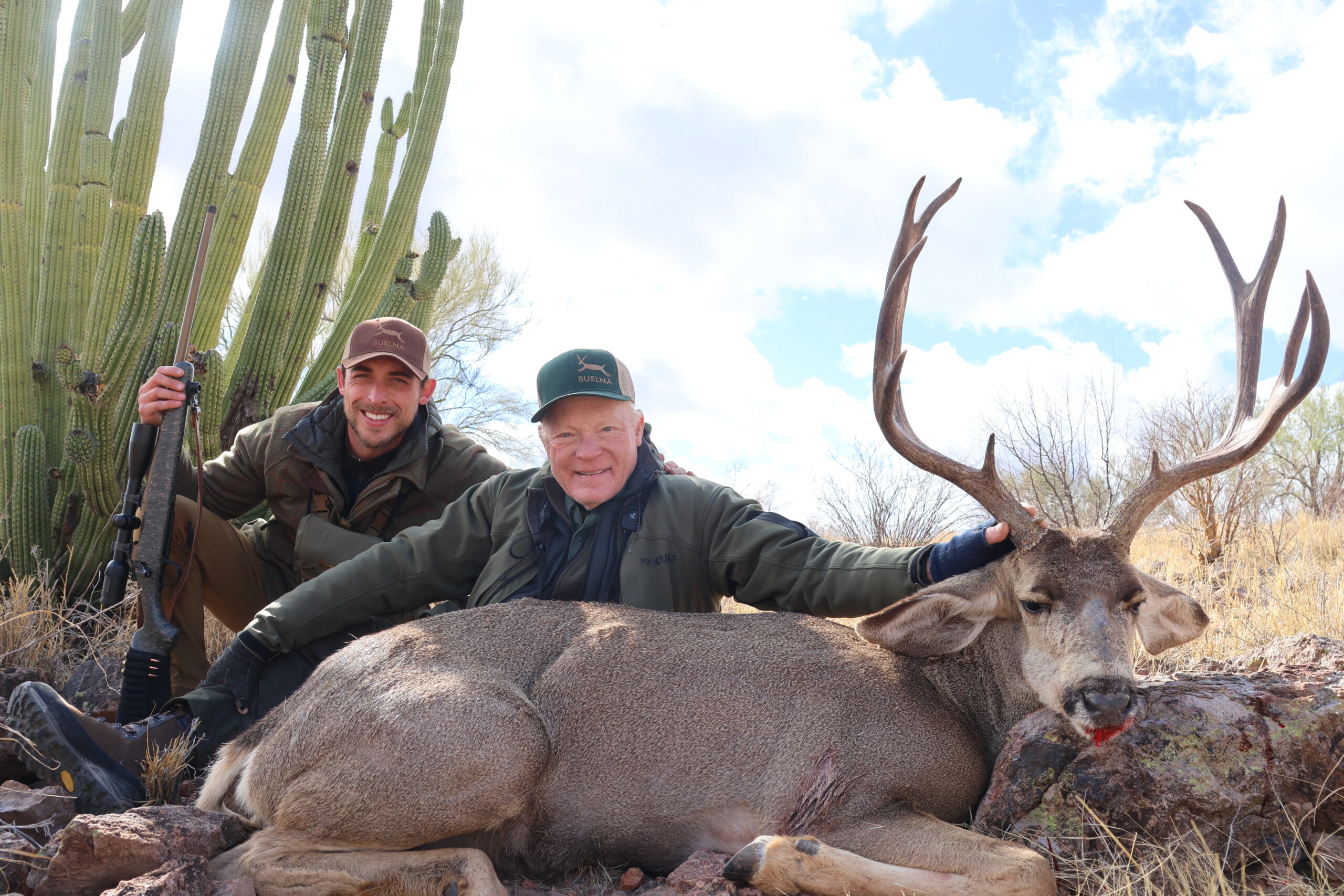We had to cut the beast in half to load it on a horse. “Not many bucks that big,” Stuart allowed, squinting into wind that bowed the conifers. The blizzard blasted the cliffs, curtained the blackness below. Night brought us, snow-plastered, to the truck.
I’ve not found a heavier deer than that B.C. muley, or killed one with thicker, taller antlers. Can’t expect to. But bagging a smaller deer shouldn’t have been so difficult.
“You don’t hunt muntjac to fill freezers,” Oliver Power said of these collie-size deer. “They don’t stand around to get shot. Sometimes you can’t even find them.”
A strange claim, I thought, as we motored through the English countryside where Oliver operates Tusk and Antler Outfitting. This wasn’t the northern Rockies. The tiny woodlots brought to mind beech groves that had yielded fox squirrels to my first .22. It was hard to believe any deer could hide either side of the stone fencerows carving this landscape into a patchwork of field and forest.
Oliver pulled the Land Rover to a stop on a muddy track. You could have covered the hoof-print with a quarter. Except for a young buck on the last day of my hunt, these little quotes would be as close as I would come to killing England’s elusive fanged deer.
“This animal is not extinct,” Oliver assured me a week later. “You’ll have to return, try again.”
Small comfort, this, to be beaten by a dog-size deer in woodlots smaller than soccer fields. “Don’t you have any other big game?” I groused.
“As a matter of fact, we do.”
Two years hence I spied Oliver’s lanky frame protruding above harried hundreds scurrying about Heathrow. I made my way over.
“No rifle?”
“Muntjac made me out a fool; but credit me for sparing us an hour with your Bobbies.”
Oliver nodded. “You can use my 6.5×55.”
He herded the Rover expertly through London traffic and onto highways choked with commuters. “It’s always rush hour here. You’ll like where we’re hunting roe bucks.”
If Europe has a counterpart to the whitetail, it’s the roe deer. Bigger than muntjac, smaller than our pronghorn, it has a civilized bovid mouth and thrives in whitetail-like habitat. Prolific and evasive, it endures under months-long but carefully throttled hunting….
A decade earlier, on a dark, deserted street, I had seen him ghost from the shadows and stand in the drizzle, looking about. He pulled the collar of his great-coat tight. I left the window, descended the hotel’s creaking stairs and went out into the night. He eyed me, said something that in a movie would have passed for Soviet code, then led me to his car, a Skoda that predated my first solid food. He spoke no English as we motored through a steady rain. He pulled up between brambles in a narrow, puddled lane. We got out. I followed him to a tree with a hochstand in its crown of heavy limbs and climbed up beside him. He found a cigarette. The match lit his lined face. He pointed into the dark and handed me his rifle.
Dawn shut heaven’s spigot and replaced the rain with fog. Through it, I spied the wraith-like form of a small deer. It dodged in dainty jinks across the sodden field, its legs never still, feet never seeming to land. I feared it wouldn’t stop. But it did. The blast of the .308 sent it off like a rocket. We found it dead.
“That was my one and only roe deer,” I told Oliver.
“Antlers?”
“Gnarled nubs, not an inch long. It was a very old buck.”
“What many Europeans covet as a trophy,” mused my guide. “We’ll look for an arthritic animal whose antlers haven’t yet regressed.”
We motored on patched macadam a few dozen clicks, to a forest gate. Oliver unlocked it, drove through and closed it. The understory thinned as the dirt lane spooled out behind us. He braked beside a weathered shooting bench fronting an alley in the trees. Minutes later I’d settled in behind the Blaser R8 and Schmidt & Bender scope. “Fire in the hole!” It may not be what the English say, but Oliver plugged his ears. A hundred steps yonder, three shots landed in a golf-ball group 2 inches to 1 o-clock.
We weren’t far from the Cotswolds where the muntjac had humbled me, where Kate Moss lives, where in earlier times shallow soil doomed farmers to hard times. Now the Cotswolds (wold means hill) have drawn investors who’ve renovated old estates distinguished by their fetching yellow building stones.
Oliver drove fast, on roads so narrow that meeting and overtaking vehicles, our tires (uh, tyres) splashed dew from the grass shoulders. Margins of gray rocks, neatly stacked by generations long dead, then pitted by decades of wind and rain, hemmed pasture and wood and defined farmsteads. Moss-rimed and ensconced in shrubbery, they gave up riots of brambles that sheltered and fed a variety of wildlife.
On my muntjac hunt, monsoon humidity had driven dawn’s frost into our bones. This time Oliver had ordered up milder weather, with just enough nip for a jacket as bright skies chased early fog.
Almost any mission to kill forest deer delivers quickest results if you sit and wait. But we’re both still-hunters at heart, the name at odds with the tactic. Moving slowly, you relinquish the stillness that hides you. It’s the price of playing fair, of seeking and finding instead of ambushing, of risking at each step instead of putting all risk on the deer. A proper rain the previous day had soaked the wood, softening footfalls. But the cover was dense; sodden sticks still snapped.
A group of fallow deer were hyphens flickering between boles. We let them pass. Soon thereafter Oliver spied a female roe deer – at least, pieces of her. She vanished silently, a vision erased.
We emerged in the tall grass of a vacated farm lane and eased along it a few yards to a fence that cleaved a planting of small trees from the forest. In the field beyond the saplings we saw him. This roe deer looked fine to me. Oliver was salivating, eyes wide behind his binocular. Alas, the animal was 90 yards out, moving away. I scooted toward a fencepost, tried to steady the Blaser. The angle gave me but a sliver of flank; the reticle skittered in and out. When at last the buck paused, it was to look back. Clearly my fencepost didn’t match the one in his memory. Reluctantly I declined the shot. The deer trotted off, slipping into a distant wood.
“You could have tried,” said Oliver. “That was a beauty.”
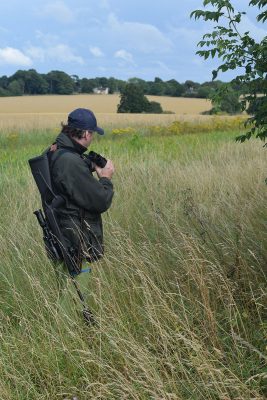 We hunted the rest of that day, and the next, without seeing any roe deer even close in size and age to that buck. By chance, we did spot a fine muntjac, uncharacteristically foraging at mid-day in a hay field that pitched off a timbered hill. “We can shoot that one!” hissed Oliver. We swung behind the hump, crawled over it. Just as I snugged the sling, the buck stiffened, as if suddenly aware of his vulnerability. He must have caught sight of our heads, mere bumps above the alfalfa. He rocketed off, slicing into the trees like a stooping hawk’s shadow.
We hunted the rest of that day, and the next, without seeing any roe deer even close in size and age to that buck. By chance, we did spot a fine muntjac, uncharacteristically foraging at mid-day in a hay field that pitched off a timbered hill. “We can shoot that one!” hissed Oliver. We swung behind the hump, crawled over it. Just as I snugged the sling, the buck stiffened, as if suddenly aware of his vulnerability. He must have caught sight of our heads, mere bumps above the alfalfa. He rocketed off, slicing into the trees like a stooping hawk’s shadow.
That evening we got lucky. Giving woods-edge one more glassing, we spied a roe deer. “It’s not the big buck, but it’s mature,” said Oliver. “You won’t get very close; but have a go. I’ll wait.”
Slipping across an opening behind a bushy cut, I found enough of a rise to fire prone. The deer vanished in recoil; the “thuck” of the hit followed. Light was leaking fast from the low ceiling. The faint silhouette of a roe deer winked across the field as we hurried forward, but we paid it no mind – until we’d searched where the buck had dropped. He was gone. Sopping vegetation showed no blood. We surmised, after a repeat canvassing by flashlight, that my bullet had clipped a spinal process. “The deer zipping for cover had to be your deer,” Oliver concluded. Given its gait and our failure to find blood, it couldn’t have been badly injured. Still, I was duly upset.
The little deer of England were having their way with me. “We’ve one more day,” said Oliver. “Weather’s clearing. We’ll look again for that big roe deer.”
We took the same path, easing through thickets as morning sun winked from wet leaves. We saw hares and a pheasant, fallow deer and a pair of young roe. The first day’s buck, now a giant in memory, was nowhere to be found. We converged on the lane. “Let’s swing around yon pasture,” Oliver suggested.
We didn’t reach it. On an open slope, head down, the buck of our dreams fed as if he’d not eaten in months. He was farther than I’d have liked, but with no cover between us, I dared not risk an approach. I flopped prone, nudged the Blaser’s cocking switch forward and quartered the shoulder. The blast faded without comment. A blink’s pause, and the deer jumped, then broke into a trot. The R8’s bolt closed on a fresh round, but I didn’t fire. Bullets strike deer audibly. Stricken animals seldom pause, even for a blink. Surely I had missed, though my call was good. I wouldn’t fire at a deer trotting off in good health.
There the hunt might have ended. But I hadn’t moved. Unaccountably, the buck halted, reversing to walk back toward the cover from which he’d come. When he stopped, I almost demurred. Twice my bullets had strayed. But the crosswire quivered to a near-stall….
The 6.5×55 bullet landed with a solid, lethal ring. Still, I ran to where the animal had collapsed. It was dead, a drop of blood glistening just where I’d held.
“Oh, yes!” exclaimed Oliver, close on my heels. “He’s the one! And bigger than he looked! Nine points! Look at those knobby beams! A gold medal buck for sure!”
It was. But on that brilliant morning after the storms, what mattered most was the clean finish and the hours of still-hunting that delivered it. While the undeserved second shot hardly erased earlier failures, every step in a hunt figures into its result. All had a hand in pulling from England’s ancient coverts the biggest little deer that may ever fall to my rifle.—Wayne Van Zwoll

